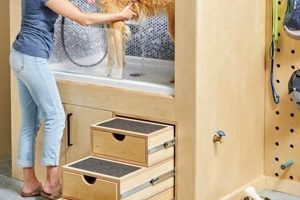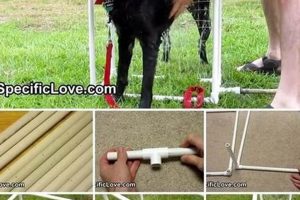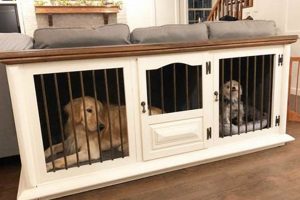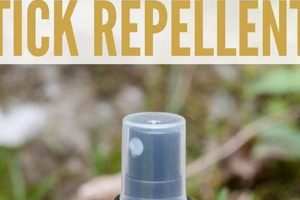A homemade solution designed to mitigate unpleasant canine odors offers an alternative to commercially produced products. These typically involve combining readily available household ingredients to create a spray, wipe, or powder intended to neutralize or mask smells emanating from a dog’s coat, skin, or bedding. An example includes combining water, vinegar, and essential oils in a spray bottle for application after a walk.
The appeal of crafting odor-eliminating concoctions for pets stems from several factors. These include cost-effectiveness, allowing owners to potentially save money compared to purchasing pre-made items. The ability to control the ingredients used provides assurance against potential allergens or harsh chemicals that might irritate sensitive skin. Historically, household remedies have been employed for various purposes, reflecting a tradition of resourcefulness and a desire for natural alternatives. Furthermore, a prepared deodorizing agent contributes to maintaining a cleaner and more pleasant home environment for both humans and animals.
The following sections will explore specific recipes, application techniques, and safety considerations related to creating effective and appropriate odor control options for canines. Careful ingredient selection and proper application are vital to ensure the well-being of the animal and the efficacy of the deodorizing treatment.
Tips for Crafting Effective Canine Odor Control Solutions
The following provides guidance on creating safe and effective odor-eliminating treatments for dogs using homemade methods. Adherence to these recommendations minimizes the risk of adverse reactions and maximizes the potential for a positive outcome.
Tip 1: Ingredient Selection is Paramount: Exercise caution when selecting ingredients. Avoid substances known to be toxic to canines, such as tea tree oil, pennyroyal, and certain citrus oils in high concentrations. A consultation with a veterinarian is advisable before introducing new ingredients into a pet’s care routine.
Tip 2: Dilution is Key: Concentrated substances, even those considered safe, can cause skin irritation. Dilute all ingredients appropriately, following established guidelines or consulting with a veterinary professional. A general rule of thumb is to start with a highly diluted solution and gradually increase concentration only if necessary.
Tip 3: Patch Testing is Essential: Before applying a treatment to the entire animal, conduct a patch test on a small, inconspicuous area of skin. Monitor for any signs of irritation, redness, or discomfort for at least 24 hours before proceeding with full application.
Tip 4: Avoid Sensitive Areas: Exercise extreme care to prevent solutions from entering the dog’s eyes, ears, or nose. These areas are particularly sensitive and susceptible to irritation. Use a damp cloth to apply the solution around the face, rather than spraying directly.
Tip 5: Proper Storage Practices: Store solutions in clearly labeled, airtight containers, out of reach of children and pets. Discard any unused portion of a solution after a reasonable period, as natural ingredients can degrade or become contaminated over time.
Tip 6: Baking Soda Application: For dry deodorizing, baking soda can be gently massaged into the coat and then thoroughly brushed out. This assists in absorbing odors; however, avoid excessive application, as it can dry out the skin.
Tip 7: Vinegar Usage: White vinegar, when diluted with water, serves as an effective odor neutralizer. However, its acidic nature necessitates careful dilution to prevent skin irritation. The scent of vinegar dissipates relatively quickly, leaving a neutral base.
Implementing these tips promotes safer and more effective odor management for canine companions, fostering a more pleasant environment while prioritizing animal well-being.
The subsequent sections will address specific recipes and application techniques, building upon the foundational principles outlined above.
1. Safe Ingredients
The correlation between “safe ingredients” and a homemade canine odor eliminator is foundational. The efficacy of any odor-reducing formulation is secondary to the assurance that its components do not pose a health risk to the animal. The cause-and-effect relationship is direct: unsafe ingredients can trigger adverse reactions, ranging from mild skin irritation to severe systemic toxicity. Therefore, the selection of appropriate and non-toxic substances is not merely a desirable attribute, but an indispensable requirement for any credible odor control preparation. For instance, the use of tea tree oil, a common ingredient in human aromatherapy, can be highly toxic to dogs if ingested or absorbed through the skin, leading to neurological symptoms and liver damage. Conversely, diluted apple cider vinegar, a generally recognized safe substance, can be employed as an odor neutralizer and coat cleanser.
The practical significance of understanding ingredient safety extends beyond the immediate well-being of the animal. Owners bear the responsibility for ensuring the safety of any product applied to their pet. The proliferation of online recipes for canine odor control necessitates a critical evaluation of each component’s potential impact. For example, while some essential oils may possess antimicrobial properties, their concentration and delivery method must be carefully controlled to prevent dermal irritation or respiratory distress. Similarly, the use of baking soda as a dry shampoo alternative requires caution, as excessive application can lead to skin dryness and irritation. Real-world examples abound of dogs experiencing adverse reactions to poorly formulated or improperly applied homemade deodorizing agents, underscoring the vital need for informed decision-making.
In conclusion, the selection of safe ingredients is the cornerstone of any homemade canine odor control strategy. While the allure of cost-effectiveness and natural alternatives may be strong, prioritizing the animal’s health and well-being is paramount. Challenges remain in navigating the vast amount of information available and differentiating between safe and potentially harmful substances. A comprehensive understanding of ingredient properties, coupled with veterinary consultation when necessary, is essential for responsible and effective odor management in canines.
2. Proper dilution
The appropriate dilution of ingredients is a critical determinant of both the effectiveness and safety of any homemade canine odor control solution. Undiluted or improperly diluted substances can cause skin irritation, allergic reactions, or even toxicity in canines. Therefore, understanding and adhering to recommended dilution ratios is paramount when formulating such solutions.
- Concentration and Irritation
The concentration of active ingredients directly impacts the potential for skin irritation. Essential oils, for instance, are highly concentrated and can cause burns or allergic reactions if applied undiluted. Proper dilution with a carrier oil, such as coconut or almond oil, reduces the concentration to a safe level while still providing the intended odor-masking or antibacterial properties. A 1% to 2% dilution is generally recommended for topical application in dogs.
- Absorption and Toxicity
Certain substances, while potentially safe in small quantities, can become toxic if absorbed in excessive amounts through the skin. For example, while diluted vinegar is often used to neutralize odors, applying undiluted vinegar can disrupt the skin’s pH balance, leading to irritation and increased absorption of other substances. Dilution reduces the risk of systemic absorption and subsequent toxicity.
- Product Stability and Efficacy
Proper dilution can also affect the stability and efficacy of the odor control solution. Overly concentrated solutions may be unstable, leading to precipitation or separation of ingredients. This can reduce the product’s effectiveness and potentially clog spray nozzles. Appropriate dilution ensures a homogenous and stable mixture, maximizing its odor-fighting capabilities.
- Individual Sensitivity
Even with proper dilution, individual dogs may exhibit varying degrees of sensitivity to certain ingredients. Factors such as age, breed, skin condition, and pre-existing allergies can influence a dog’s response. Therefore, it is advisable to start with a highly diluted solution and gradually increase the concentration, while closely monitoring for any signs of irritation or discomfort. Patch testing on a small area of skin is also recommended prior to full application.
In summary, “proper dilution” is not merely a procedural step but a fundamental principle in the creation of homemade canine odor control solutions. Neglecting this aspect can compromise the animal’s health and the product’s effectiveness. Adherence to recommended dilution ratios, coupled with careful observation and individual sensitivity considerations, is essential for ensuring a safe and beneficial outcome.
3. Gentle application
The method of application is intrinsically linked to the success and safety of any homemade canine odor-control solution. A rough or aggressive application technique can induce stress, fear, or physical discomfort in the animal, potentially negating any benefits derived from the deodorizing agent itself. Therefore, employing a gentle approach is not merely a matter of preference, but a critical component of responsible pet care when utilizing homemade remedies.
The connection between application and the animal’s response is direct. For instance, spraying a dog directly in the face, even with a mild solution, can trigger a negative association with the treatment, making future applications more challenging. Similarly, forcefully rubbing a solution into sensitive skin can cause irritation and discomfort, leading to avoidance behavior. Conversely, a gentle application, such as lightly misting the coat or using a soft cloth to apply the solution, minimizes stress and promotes a more positive experience. Real-world examples demonstrate that dogs are more likely to cooperate with treatments when they are administered in a calm and reassuring manner. Furthermore, a gentler approach reduces the risk of accidental injury, such as inadvertently getting the solution into the animal’s eyes or ears.
The practical significance of understanding gentle application techniques extends beyond immediate comfort. A dog that is comfortable and cooperative is more likely to allow for a thorough and effective treatment. This translates to better odor control and overall hygiene. Moreover, a positive experience strengthens the bond between the owner and the animal, fostering a relationship built on trust and respect. Challenges remain in adapting application methods to individual dogs, as some may be more sensitive or resistant to handling than others. However, prioritizing gentle, non-invasive techniques is essential for ensuring the well-being of the animal and the efficacy of any homemade odor-control regimen.
4. Patch test essential
The application of any homemade canine deodorizing agent necessitates a preliminary patch test to ascertain the animal’s sensitivity to the solution’s components. A direct cause-and-effect relationship exists: the absence of a patch test can result in undetected allergic reactions or skin irritation. The “patch test essential” element serves as a preventative measure, identifying potential adverse responses before widespread application. For instance, a dog may exhibit sensitivity to a specific essential oil, such as lavender, even when properly diluted. Without a patch test, a full-body application could lead to dermatitis, characterized by redness, itching, and inflammation. The inclusion of a patch test in the “diy dog deodorizer” process thus represents a crucial step in safeguarding the animal’s health and well-being.
The execution of a patch test involves applying a small amount of the homemade deodorizer to a discreet area, typically on the dog’s flank or inner thigh, and observing for any signs of irritation over a 24-48 hour period. A real-world example would involve applying a dime-sized amount of the solution and marking the area with a non-toxic marker. During the observation period, the owner must monitor the site for redness, swelling, hives, or excessive scratching. If any of these symptoms manifest, the solution should not be used on the dog. The information gathered from the patch test informs the decision-making process regarding the suitability of the “diy dog deodorizer” for that particular animal. This proactive approach minimizes the risk of adverse cutaneous reactions, enhancing the safety profile of the homemade treatment.
In conclusion, the principle of “patch test essential” underscores the importance of responsible formulation and application of homemade canine deodorizing agents. While the allure of cost-effective and natural odor control is compelling, prioritizing the animal’s safety remains paramount. By adhering to this precautionary measure, owners can mitigate potential risks and ensure a more positive outcome when utilizing “diy dog deodorizer” solutions. The patch test serves as a critical safeguard, promoting both the effectiveness and the responsible use of homemade deodorizing treatments for canines.
5. Storage considerations
The efficacy and safety of a homemade canine deodorizing agent are inextricably linked to appropriate storage practices. Improper storage conditions can compromise the integrity of the solution, rendering it less effective or even harmful to the animal. A direct cause-and-effect relationship exists: inadequate storage leads to degradation of ingredients, potential contamination, and ultimately, a reduced capacity to control canine odors while simultaneously increasing the risk of adverse reactions. The importance of “storage considerations” stems from the inherent instability of many natural ingredients commonly employed in such preparations. Examples include essential oils, which are volatile and susceptible to oxidation when exposed to light and air, and water-based solutions, which can become breeding grounds for bacteria and mold. The practical significance of understanding these storage requirements lies in preserving the intended properties of the “diy dog deodorizer,” ensuring it remains both safe and effective for its intended purpose.
Optimal storage involves several key factors. The use of airtight, opaque containers minimizes exposure to air and light, thereby slowing down the degradation process. Storing the solution in a cool, dry place further inhibits microbial growth and chemical decomposition. Labeling the container clearly with the date of preparation is essential for tracking the solution’s age and discarding it appropriately when its shelf life expires. Furthermore, it is imperative to keep the deodorizer out of reach of children and pets, as accidental ingestion can have serious consequences. Real-life scenarios illustrate the potential dangers of neglecting storage protocols. A homemade solution left exposed to sunlight could undergo chemical changes, producing irritants that cause skin rashes in the dog. A contaminated solution could introduce harmful bacteria, leading to skin infections. Therefore, diligent adherence to proper storage practices is not merely a matter of convenience but a critical component of responsible pet ownership.
In conclusion, “storage considerations” represent an indispensable element in the creation and utilization of homemade canine deodorizing agents. Challenges remain in educating pet owners about the specific storage requirements of different ingredients and formulations. However, by emphasizing the connection between storage practices and the safety and effectiveness of “diy dog deodorizer” solutions, it is possible to mitigate risks and promote responsible use. Ultimately, prioritizing proper storage contributes to the overall well-being of the animal and the maintenance of a hygienic home environment.
6. Regular Grooming
Regular grooming practices significantly influence the efficacy of any homemade canine deodorizing agent. A direct correlation exists: consistent grooming reduces the underlying causes of canine odor, thereby diminishing the need for, or enhancing the effectiveness of, a “diy dog deodorizer”. Neglecting regular grooming leads to a buildup of dirt, debris, and dead skin cells, creating an environment conducive to bacterial growth and unpleasant odors. Furthermore, matted fur traps moisture and exacerbates skin conditions, contributing to increased odor production. Therefore, regular grooming is not merely a supplementary activity but a foundational element in managing canine odor and maximizing the impact of a homemade solution. For instance, brushing a dog with a long coat several times a week removes loose fur and prevents matting, improving air circulation and reducing moisture retention. Similarly, regular bathing with a mild shampoo helps to remove accumulated dirt and oils that contribute to odor. The inclusion of regular grooming in a canine hygiene regimen thus directly impacts the success of a “diy dog deodorizer”.
The practical significance of understanding the relationship between grooming and deodorizing lies in optimizing the overall management of canine odor. A homemade deodorizer serves as a supplementary tool, addressing lingering odors that may persist despite regular grooming. However, it cannot compensate for a complete lack of grooming. An effective approach involves establishing a consistent grooming schedule, including brushing, bathing, and ear cleaning, tailored to the dog’s breed, coat type, and lifestyle. The homemade deodorizer then serves as a targeted treatment for specific odor issues, such as post-walk odors or localized areas of concern. Real-world scenarios demonstrate the benefits of this integrated approach. A dog that is regularly brushed and bathed will require less frequent application of a deodorizer, and the deodorizer will be more effective at neutralizing odors on a clean coat. Additionally, regular grooming allows for early detection of skin problems or infections that may be contributing to odor, enabling prompt veterinary intervention.
In conclusion, “Regular Grooming” is an essential prerequisite for the effective implementation of a “diy dog deodorizer” strategy. Challenges remain in educating pet owners about the importance of consistent grooming and tailoring grooming practices to individual canine needs. However, by emphasizing the interdependence of grooming and deodorizing, and by providing practical guidance on establishing effective grooming routines, it is possible to optimize canine hygiene and minimize reliance on homemade odor-control solutions. Ultimately, prioritizing regular grooming contributes to the overall health and well-being of the animal, reducing the need for, and enhancing the efficacy of, any supplementary deodorizing treatment.
Frequently Asked Questions
This section addresses common inquiries regarding the creation and implementation of homemade canine odor control solutions. The information provided aims to clarify misconceptions and promote responsible usage.
Question 1: What are the primary risks associated with using a homemade dog deodorizer?
Potential risks include allergic reactions to specific ingredients, skin irritation due to improper dilution, and toxicity from the ingestion or absorption of unsafe substances. Adherence to established safety guidelines is paramount.
Question 2: How frequently can a homemade dog deodorizer be safely applied?
The frequency of application depends on the individual dog’s breed, coat type, activity level, and sensitivity. Overuse can lead to skin dryness and irritation. As a general guideline, application should not exceed once per week, and should be adjusted based on the animal’s response.
Question 3: Can essential oils be safely used in a homemade dog deodorizer?
Certain essential oils are considered toxic to dogs. If essential oils are used, they must be properly diluted with a carrier oil and used in low concentrations. Veterinary consultation is recommended before incorporating essential oils into a homemade solution.
Question 4: What are some signs that a homemade dog deodorizer is causing an adverse reaction?
Signs of an adverse reaction include redness, itching, hives, swelling, hair loss, excessive scratching or licking, lethargy, and gastrointestinal upset. If any of these symptoms occur, discontinue use immediately and consult a veterinarian.
Question 5: How can the shelf life of a homemade dog deodorizer be maximized?
To maximize shelf life, store the solution in an airtight, opaque container, in a cool, dry place, away from direct sunlight. Discard any solution that exhibits signs of discoloration, separation, or foul odor.
Question 6: Is a homemade dog deodorizer a substitute for regular grooming?
No. A homemade dog deodorizer is a supplementary tool, not a replacement for regular grooming practices. Regular brushing, bathing, and professional grooming are essential for maintaining canine hygiene and minimizing odor.
The information provided in this FAQ section is intended for general knowledge and informational purposes only, and does not constitute veterinary advice. Always consult with a qualified veterinarian for any questions you may have regarding your pet’s health or treatment.
The following section explores specific recipes for homemade canine deodorizers, building upon the foundational principles outlined thus far.
Conclusion
The preceding analysis has thoroughly examined the multifaceted considerations surrounding “diy dog deodorizer” solutions. The exploration has highlighted the critical importance of safe ingredient selection, proper dilution techniques, gentle application methods, the necessity of patch testing, and the impact of appropriate storage. The supplementary role of regular grooming in minimizing odor and maximizing the efficacy of homemade treatments has also been emphasized. The information presented underscores the potential benefits and inherent risks associated with creating and utilizing such preparations.
The responsible creation and implementation of a “diy dog deodorizer” requires a diligent and informed approach. The well-being of the animal must remain the paramount concern, dictating the selection of ingredients, application methods, and frequency of use. Careful consideration of the information provided will empower pet owners to make informed decisions and promote a safer, more hygienic environment for both themselves and their canine companions. Continued vigilance and consultation with veterinary professionals are encouraged to ensure ongoing responsible practices.







